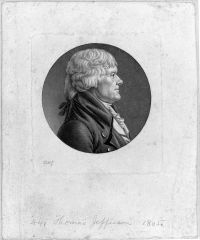Jefferson Portrait by Saint-Mémin (Physiognotrace)
Artist/Maker: Charles Fevret de Saint-Mémin (1770-1852)
Created: 1804
Origin/Purchase: Washington, D.C.
Materials: pastel, wash, and chalk on paper
Dimensions: 58.7 × 43.2 (23 1/8 × 17 in.)
Provenance: Thomas Jefferson; unknown until owned by George Bancroft; by descent to John Chandler Bancroft; by descent to Wilder D. Bancroft; by purchase to Worcester Art Museum in 1954
Historical Notes: When the French émigré Charles Fevret de Saint-Mémin introduced physiognotrace portraits to the United States in 1797, Jefferson was already acquainted with the use of a mechanical device to trace a sitter's profile. Eight years earlier in Paris, Jefferson sat for a life-size crayon physiognotrace portrait by the machine's inventor, Gilles-Louis Chrétien. Using a pantograph, Chrétien then reduced the original profile to a miniature copperplate from which multiple engravings could be printed.
Jefferson was probably the first American to have his profile taken by the physiognotrace. He and Gouverneur Morris went together to the Palais Royal on April 22, 1789, to purchase tickets for sittings. The next day Jefferson sat for Chrétien and his partner Edmé Quenedey (1756-1830) at their studio. Six days later Jefferson picked up the copperplate of his portrait and twelve prints taken from it. Curiously, Jefferson made no further reference to these prints, and none are known to survive with his family.[1]
On the other hand, the portrait of Jefferson done by Saint-Mémin in 1804 was widely distributed both by the artist and by Jefferson, and it became one of the best-known likenesses of Jefferson in his day.[2] Saint-Mémin came to the United States from Dijon, France, in 1793.
The cost and size of Saint-Mémin's engravings made them immensely popular gifts among friends, relatives, and colleagues. Jefferson's print collection included at least a dozen of the artist's miniatures, many of which were exhibited in the Tea Room. For twenty-five dollars ($250 today) a gentleman could purchase his original crayon drawing, the engraved copperplate, and twelve engravings. The cost for ladies was ten dollars more, and an additional twelve prints cost only one dollar and fifty cents.[3]
Jefferson's children entreated their father to have his portrait taken by the Frenchman. In February 1804, Maria Jefferson Eppes, the younger of Jefferson's two daughters, wrote to her father in Washington from her sickbed:
[W]e had both thought you had promised us your picture if ever St Mimin went to Washington, if you did but know what a source of pleasure it would be to us while so much separated from you to have so excellent a likeness of you you would not I think refuse us, it is what we have allways most wanted all our lives & the certainty with which he takes his likenesses makes this one request I think not unreasonable.[4]
Maria did not live long enough to see her father's portrait, but her sister Martha was very fond of the likeness. Both she and her eldest daughter, Anne Cary Bankhead, requested additional prints for friends and associates near Monticello.[5] Jefferson purchased a total of forty-eight prints from Saint-Mémin after his November sitting, which he gave to his family, members of his Cabinet, and friends, including the comte de Volney and the marquis de Lafayette.[6] Saint-Mémin produced additional prints in an oval frame on the eve of Jefferson's second inauguration for sale to the public.[7]
- Text from Stein, Worlds, 198
Further Sources
- Smithsonian Institution. "Thomas Jefferson by Saint-Mémin."
- Worcester Art Museum. "Charles-Balthazar-Julien Févret De Saint-Mémin: Thomas Jefferson." Provides an image of the drawing, along with text by the Worcester Art Museum curators.
References
- ^ Howard Rice, "A 'New' Likeness of Thomas Jefferson," The William and Mary Quarterly 3rd ser., vol. 6, no. 1 (January 1949): 84-89.
- ^ Howard Rice, "Saint-Mémin's Portrait of Jefferson," Princeton University Library Chronicle vol. xx, no. 4 (Summer 1959): 182-92.
- ^ Fillmore Norfleet, Saint-Mémin in Virginia: Portraits and Biographies (Richmond: Dietz Press, 1942), 28.
- ^ Mary (Maria) Jefferson Eppes to Jefferson, February 10, 1804, in PTJ, 42:442-43. Transcription available at Founders Online.
- ^ Maria died on April 17, 1804. Anne Cary Randolph to Jefferson, December 19, 1808, in Family Letters, 371 (transcription available at Founders Online); Martha Jefferson Randolph to Jefferson, March 2, 1809, in Family Letters, 388 (transcription available at Founders Online).
- ^ Noble E. Cunningham, Popular Images of the Presidency from Washington to Lincoln (Columbia: University of Missouri Press, 1991), 82; Thomas Jefferson, undated list of names following sheet of paper labeled "Profiles by St. Mémin," Thomas Jefferson Papers, Special Collections, University of Virginia.
- ^ Norfleet, Saint-Mémin in Virginia, 31. Norfleet suggests that Jefferson sat for Saint-Mémin twice; however, Rice and Alfred Bush argue that there was only one sitting from which two engravings were made. See Rice, "Portrait," 183, and Bush, Life Portraits, 51-53. The round copper-plate from the first portrait is owned by Princeton University Library, and Alderman Library at the University of Virginia owns Saint-Mémin's oval copperplate.
